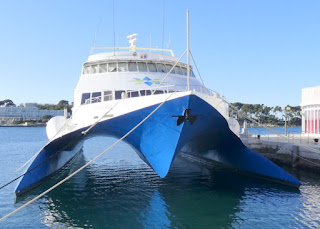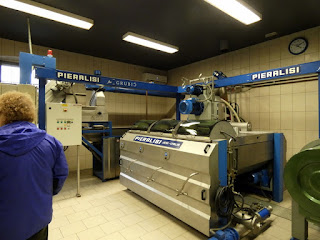Today we drove north and east around sort of a fjord before going back to the coast and Porec (poor-rech) which is home to a UNESCO basilica and a bee farm a bit inland.
 |
| Dawn |
 |
| Two views (above/below) of the fjord |
 |
| The blue dots are a mussel farm |
 |
Map of where we drove. We started from the coastal
blob on the bottom, stopped along the fjord above,
and continued to Porec, on the coast by the red dot
near the top of the map. |
|
We explored Porec first, which is a classic old Roman town in its grid shape which retains its original street names. It is a popular tourist destination. It has a harbor protected by a nearby island. The Euphrasian basilica here has undergone several transformations over the centuries. starting in the 4th century. It has been in continuous operation since it was first built. Inside there are detailed mosaics in the altar area and Alessandro pointed out some interesting aspects, such as the depiction of both Mary and the mother of John the Baptist as pregnant women.
 |
The Venetian lion with an open book shows the area was captured
without warfare. Closed books indicate conflict. |
 |
| Venetian lions are everywhere |
 |
| Remains of fresco |
 |
| Original mosaic floor about 18 inches under the current one. |
 |
Mary is shown sitting on a throne (Byzantine?) and baby
Jesus looks pretty old. Older depictions are simpler and
Jesus looks more baby-like. |
 |
| The pregnant mothers. Mary is on the right |
 |
| Older defunct part |
 |
| Diagram of how the church has changed. |
We had an opportunity to walk around, and since it was Sunday morning around 9am, the place was pretty empty and quiet. Several streets had their original Roman paving, and the waterfront area was quite lovely. Back on the bus, Alessandro brought us a local delicacy called porek -- apparently a puff pastry stuffed with a ricotta filling. Surprisingly, it was not sweet and a small piece was quite adequate.
 |
| Starting our coastal walk |
 |
This fancy ship was parked next to the town casino. It looked like a
normal sleek ship and then we walked past the front. |
 |
Modern sculpture in the town square. I assumed she is wearing a thong
bikini and high heels, but maybe its really her undies. |
We headed out to the beekeeper's location and learned about what is in the bee boxes and how the queen is kept in the bottom section. They also raise animals and had a big bunch of cute piglets as well as goats, chickens, and geese. Herbs like rosemary, sage, and lavender were other key crops. Their honey is different in that they focus on incorporating their dried herbs in the honey for their preventive medicinal value, a lot like how the Chinese use their varieties of loose leaf tea. We were given tastes of mint, sage, and rosemary, none of which I was keen on, but I did buy some of their un-herbed creamed honey.
 |
| Walking up to Remedy Farn |
 |
The piglets started out in an enclosed area, but you can see there is a
secret escape route and they wanted water near where we were, they
exited and now they are returning. |
We returned to the boat for lunch and I took a bit of a nap. I had stayed up late working on the blog (and posted the first two chapters) and needed the rest. At three, we boarded the bus again and drove south east to an olive oil mill in Bale (bah-lay). We arrived before the other group (there are two separate small groups on the ship) was finished so we walked around the town and looked at a couple churches, including a very small old one with intact frescos.
 |
15th century Church of the Holy Spirit. Unfortunately, the
fresco photosI took looked ok in the
viewfinder when I took them, but are totally black on the screen. |
 |
| A citadel from the 14th century. The arch is the entrance to the old town. |
 |
Tower at St. Elizabeth's church, on the site of a 5th
century church. There have been 5 churches
on this site. |
Then it was our turn in the mill. The machinery was very similar (but smaller) to the elaborate mill we had visited near Florence three years ago. For the best freshness, olives should be pressed within 24 hours of picking and this area of Istria is apparently renown for its high quality of olives. After learning about how the oil was produced, we went to the tasting area and got a lesson in the process and chance to try each of their three products. They also served little open faced sandwiches and an orange tart that they drizzled olive oil on and I was reminded of how differently they view the use of olive oil vs. what I have experienced. We ended up getting some of their oil and headed back to the ship for dinner and entertainment.
 |
| The family also showcased older versions of olive oil making. |
 |
| This was used to filter the solids out of the crushed olives. |
We are supposed to learn about Italian hand gestures, but since this is our fourth trip to Italy with OAT, it would be our third or fourth lesson, so I skipped it to get more caught up on the blog.
































No comments:
Post a Comment